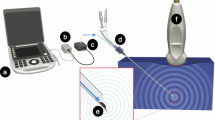Abstract
Background
Good hand-eye coordination is a prerequisite for safe ultrasound-guided peripheral nerve blocks. However, new skills have to be acquired when compared to the traditional nerve stimulation technique. We tested and mathematically described the learning curve of these skills in inexperienced ultrasound users employing a simple phantom of a peripheral nerve.
Methods
A simple phantom made from a piece of spaghetti to simulate a nerve, within a starch core and embedded in gelatine was used for ultrasound-guided simulation of a peripheral nerve block. Eighteen medical students who were novices to ultrasound were enrolled. Serial time to successful injection was measured. Quality of injection was rated by two independent observers.
Results
Time to successful injection improved from a median of 66.5 s (49.5–90) for the first trial to 37 s (23.5–53.5) for the 11th trial. A plateau of 30 s was reached for t 1/2 after 2.7 trials and 4 × t 1/2 after 7.8 trials when described as first-order exponential decay. Time to successful injection was significantly shortened after 5 trials. Quality of injection with numbers of trials followed a sigmoidal shape with 50 % of maximum quality after 3.6 trials and a plateau after 8.5 trials. Likewise, a significant improved quality of injection was reached after 5 trials.
Conclusion
Based on our mathematical analyses of the learning curve, inexperienced ultrasound users can improve their hand-eye coordination within 5 subsequent trials in a simple model of a peripheral nerve block.






Similar content being viewed by others
References
Marhofer P, Harrop-Griffiths W, Kettner SC, Kirchmair L. Fifteen years of ultrasound guidance in regional anaesthesia: part 1. Br J Anaesth. 2010;104:538–46.
Sites BD, Brull R, Chan VW, Spence BC, Gallagher J, Beach ML, Sites VR, Hartman GS. Artifacts and pitfall errors associated with ultrasound-guided regional anesthesia. Part I: understanding the basic principles of ultrasound physics and machine operations. Reg Anesth Pain Med. 2007;32:412–8.
Sites BD, Brull R, Chan VW, Spence BC, Gallagher J, Beach ML, Sites VR, Abbas S, Hartman GS. Artifacts and pitfall errors associated with ultrasound-guided regional anesthesia. Part II: a pictorial approach to understanding and avoidance. Reg Anesth Pain Med. 2007;32:419–33.
Neal JM, Brull R, Chan VW, Grant SA, Horn JL, Liu SS, McCartney CJ, Narouze SN, Perlas A, Salinas FV, Sites BD, Tsui BC. The ASRA evidence-based medicine assessment of ultrasound-guided regional anesthesia and pain medicine: executive summary. Reg Anesth Pain Med. 2010;35:S1–9.
Schuepfer G, Konrad C, Schmeck J, Poortmans G, Staffelbach B, Johr M. Generating a learning curve for pediatric caudal epidural blocks: an empirical evaluation of technical skills in novice and experienced anesthetists. Reg Anesth Pain Med. 2000;25:385–8.
Sites BD, Gallagher JD, Cravero J, Lundberg J, Blike G. The learning curve associated with a simulated ultrasound-guided interventional task by inexperienced anesthesia residents. Reg Anesth Pain Med. 2004;29:544–8.
Baranauskas MB, Margarido CB, Panossian C, Silva ED, Campanella MA, Kimachi PP. Simulation of ultrasound-guided peripheral nerve block: learning curve of CET-SMA/HSL anesthesiology residents. Rev Bras Anestesiol. 2008;58:106–11.
Martin G, Lineberger CK, MacLeod DB, El-Moalem HE, Breslin DS, Hardman D, D’Ercole F. A new teaching model for resident training in regional anesthesia. Anesth Analg. 2002;95:1423–7, table of contents.
Orebaugh SL, Williams BA, Kentor ML. Ultrasound guidance with nerve stimulation reduces the time necessary for resident peripheral nerve blockade. Reg Anesth Pain Med. 2007;32:448–54.
Shorten GD, O’Sullivan O. Simulation for training in ultrasound-guided peripheral nerve blockade. Int Anesthesiol Clin. 2010;48:21–33.
Rosenberg AD, Popovic J, Albert DB, Altman RA, Marshall MH, Sommer RM, Cuff G. Three partial-task simulators for teaching ultrasound-guided regional anesthesia. Reg Anesth Pain Med. 2012;37:106–10.
Author information
Authors and Affiliations
Corresponding author
Additional information
S.-C. Kim and S. Hauser contributed equally to this work.
About this article
Cite this article
Kim, SC., Hauser, S., Staniek, A. et al. Learning curve of medical students in ultrasound-guided simulated nerve block. J Anesth 28, 76–80 (2014). https://doi.org/10.1007/s00540-013-1680-y
Received:
Accepted:
Published:
Issue Date:
DOI: https://doi.org/10.1007/s00540-013-1680-y




